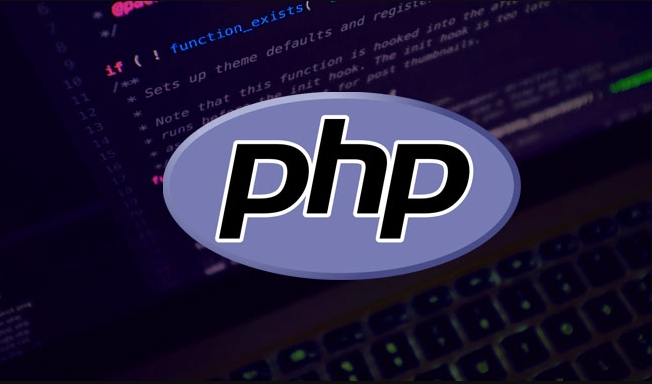The steps to deploy a PHP environment to a cloud server include: 1. Select the appropriate cloud service provider and server configuration; 2. Install PHP and common extensions; 3. Configure the web server and site directory; 4. Set up the database and test the connection. First, you should choose a service provider with one-click mirror installation function. It is recommended to configure it at least 1 core 2G memory and a 20GB system disk; secondly, use apt on Ubuntu to install PHP and necessary extensions, and verify whether the installation is successful; then put the project into the default website root directory and set permissions, or configure the virtual host as needed; finally install MySQL or MariaDB, create a database and user, and test whether the environment is running normally through the phpinfo() page. The entire process needs to pay attention to details such as permissions, service restart and configuration file path.

Deploying a PHP environment to a cloud server is not complicated. As long as you follow the steps step by step, most people can handle it. The following content starts with preparing the server, talking about installing PHP and related components, and then simple configuration, suitable for beginners and projects that want to go online quickly.

Choose the right cloud server
The first step is to choose a reliable cloud service provider. Platforms such as Alibaba Cloud, Tencent Cloud, AWS, and DigitalOcean are all good choices, especially for those who have just started it. It is recommended to choose a service provider with one-click mirror installation function, which can save a lot of time in building a basic environment.

- If you are familiar with Linux, you can choose Ubuntu or CentOS image to install your own environment.
- If you are not familiar with it, you can directly select "LAMP" or "LEMP" pre-installed mirror, which has integrated Apache/Nginx, MySQL and PHP.
- The recommended minimum configuration is: 1 core 2G memory, and the system disk is at least 20GB.
Install PHP and common extensions
If you are using Ubuntu system, you can quickly install PHP through apt. for example:
sudo apt update sudo apt install php php-cli php-mysql php-curl php-gd php-mbstring php-xml unzip -y
These extensions are required to run most PHP applications such as WordPress, Discuz, etc. Different projects may also require additional extensions, such as Redis and OPcache, which can be installed on demand in the future.

- After the installation is completed, execute
php -vto check whether the installation is successful. - If using Nginx or Apache, remember to restart the service to make PHP take effect.
Configure the Web server and site directory
This step is mainly to connect your PHP project to the web server, taking Apache as an example:
- Put the project file in
/var/www/html/directory, this is the default website root directory. - Modify permission:
sudo chown -R www-data:www-data /var/www/html - If using a virtual host, you can create a new
.conffile under/etc/apache2/sites-available/, and then enable and restart Apache.
If you are using Nginx, the main modification is nginx.conf or root pointer in the site configuration file to ensure that index.php is in the loading order of the home page.
Database connection and test page
After the PHP environment is set up, don't forget the database support. Generally used with MySQL or MariaDB:
sudo apt install mysql-server mysql -u root -p
After creating the database and users, just test the connection in PHP through PDO or mysqli.
You can write a simple test.php file and put it in the website directory:
<?php phpinfo(); ?>
Visit this page to see detailed information about the current PHP, including installed extensions and configuration items, for easy troubleshooting.
Basically that's it. The whole process seems a bit too many, but in fact, each step is not difficult. The key is to pay attention to details, such as permission settings, service restarts, configuration file paths, etc. The most prone thing for beginners to make mistakes is often not the technology itself, but the missed a certain step or the missed command.
The above is the detailed content of Steps to deploy a PHP environment on a cloud server. For more information, please follow other related articles on the PHP Chinese website!

Hot AI Tools

Undress AI Tool
Undress images for free

Undresser.AI Undress
AI-powered app for creating realistic nude photos

AI Clothes Remover
Online AI tool for removing clothes from photos.

Clothoff.io
AI clothes remover

Video Face Swap
Swap faces in any video effortlessly with our completely free AI face swap tool!

Hot Article

Hot Tools

Notepad++7.3.1
Easy-to-use and free code editor

SublimeText3 Chinese version
Chinese version, very easy to use

Zend Studio 13.0.1
Powerful PHP integrated development environment

Dreamweaver CS6
Visual web development tools

SublimeText3 Mac version
God-level code editing software (SublimeText3)
 How to use PHP to build social sharing functions PHP sharing interface integration practice
Jul 25, 2025 pm 08:51 PM
How to use PHP to build social sharing functions PHP sharing interface integration practice
Jul 25, 2025 pm 08:51 PM
The core method of building social sharing functions in PHP is to dynamically generate sharing links that meet the requirements of each platform. 1. First get the current page or specified URL and article information; 2. Use urlencode to encode the parameters; 3. Splice and generate sharing links according to the protocols of each platform; 4. Display links on the front end for users to click and share; 5. Dynamically generate OG tags on the page to optimize sharing content display; 6. Be sure to escape user input to prevent XSS attacks. This method does not require complex authentication, has low maintenance costs, and is suitable for most content sharing needs.
 How to use PHP combined with AI to achieve text error correction PHP syntax detection and optimization
Jul 25, 2025 pm 08:57 PM
How to use PHP combined with AI to achieve text error correction PHP syntax detection and optimization
Jul 25, 2025 pm 08:57 PM
To realize text error correction and syntax optimization with AI, you need to follow the following steps: 1. Select a suitable AI model or API, such as Baidu, Tencent API or open source NLP library; 2. Call the API through PHP's curl or Guzzle and process the return results; 3. Display error correction information in the application and allow users to choose whether to adopt it; 4. Use php-l and PHP_CodeSniffer for syntax detection and code optimization; 5. Continuously collect feedback and update the model or rules to improve the effect. When choosing AIAPI, focus on evaluating accuracy, response speed, price and support for PHP. Code optimization should follow PSR specifications, use cache reasonably, avoid circular queries, review code regularly, and use X
 PHP calls AI intelligent voice assistant PHP voice interaction system construction
Jul 25, 2025 pm 08:45 PM
PHP calls AI intelligent voice assistant PHP voice interaction system construction
Jul 25, 2025 pm 08:45 PM
User voice input is captured and sent to the PHP backend through the MediaRecorder API of the front-end JavaScript; 2. PHP saves the audio as a temporary file and calls STTAPI (such as Google or Baidu voice recognition) to convert it into text; 3. PHP sends the text to an AI service (such as OpenAIGPT) to obtain intelligent reply; 4. PHP then calls TTSAPI (such as Baidu or Google voice synthesis) to convert the reply to a voice file; 5. PHP streams the voice file back to the front-end to play, completing interaction. The entire process is dominated by PHP to ensure seamless connection between all links.
 PHP creates a blog comment system to monetize PHP comment review and anti-brush strategy
Jul 25, 2025 pm 08:27 PM
PHP creates a blog comment system to monetize PHP comment review and anti-brush strategy
Jul 25, 2025 pm 08:27 PM
1. Maximizing the commercial value of the comment system requires combining native advertising precise delivery, user paid value-added services (such as uploading pictures, top-up comments), influence incentive mechanism based on comment quality, and compliance anonymous data insight monetization; 2. The audit strategy should adopt a combination of pre-audit dynamic keyword filtering and user reporting mechanisms, supplemented by comment quality rating to achieve content hierarchical exposure; 3. Anti-brushing requires the construction of multi-layer defense: reCAPTCHAv3 sensorless verification, Honeypot honeypot field recognition robot, IP and timestamp frequency limit prevents watering, and content pattern recognition marks suspicious comments, and continuously iterate to deal with attacks.
 PHP realizes commodity inventory management and monetization PHP inventory synchronization and alarm mechanism
Jul 25, 2025 pm 08:30 PM
PHP realizes commodity inventory management and monetization PHP inventory synchronization and alarm mechanism
Jul 25, 2025 pm 08:30 PM
PHP ensures inventory deduction atomicity through database transactions and FORUPDATE row locks to prevent high concurrent overselling; 2. Multi-platform inventory consistency depends on centralized management and event-driven synchronization, combining API/Webhook notifications and message queues to ensure reliable data transmission; 3. The alarm mechanism should set low inventory, zero/negative inventory, unsalable sales, replenishment cycles and abnormal fluctuations strategies in different scenarios, and select DingTalk, SMS or Email Responsible Persons according to the urgency, and the alarm information must be complete and clear to achieve business adaptation and rapid response.
 How to use PHP to combine AI to generate image. PHP automatically generates art works
Jul 25, 2025 pm 07:21 PM
How to use PHP to combine AI to generate image. PHP automatically generates art works
Jul 25, 2025 pm 07:21 PM
PHP does not directly perform AI image processing, but integrates through APIs, because it is good at web development rather than computing-intensive tasks. API integration can achieve professional division of labor, reduce costs, and improve efficiency; 2. Integrating key technologies include using Guzzle or cURL to send HTTP requests, JSON data encoding and decoding, API key security authentication, asynchronous queue processing time-consuming tasks, robust error handling and retry mechanism, image storage and display; 3. Common challenges include API cost out of control, uncontrollable generation results, poor user experience, security risks and difficult data management. The response strategies are setting user quotas and caches, providing propt guidance and multi-picture selection, asynchronous notifications and progress prompts, key environment variable storage and content audit, and cloud storage.
 Beyond the LAMP Stack: PHP's Role in Modern Enterprise Architecture
Jul 27, 2025 am 04:31 AM
Beyond the LAMP Stack: PHP's Role in Modern Enterprise Architecture
Jul 27, 2025 am 04:31 AM
PHPisstillrelevantinmodernenterpriseenvironments.1.ModernPHP(7.xand8.x)offersperformancegains,stricttyping,JITcompilation,andmodernsyntax,makingitsuitableforlarge-scaleapplications.2.PHPintegrateseffectivelyinhybridarchitectures,servingasanAPIgateway
 PHP integrated AI speech recognition and translator PHP meeting record automatic generation solution
Jul 25, 2025 pm 07:06 PM
PHP integrated AI speech recognition and translator PHP meeting record automatic generation solution
Jul 25, 2025 pm 07:06 PM
Select the appropriate AI voice recognition service and integrate PHPSDK; 2. Use PHP to call ffmpeg to convert recordings into API-required formats (such as wav); 3. Upload files to cloud storage and call API asynchronous recognition; 4. Analyze JSON results and organize text using NLP technology; 5. Generate Word or Markdown documents to complete the automation of meeting records. The entire process needs to ensure data encryption, access control and compliance to ensure privacy and security.






